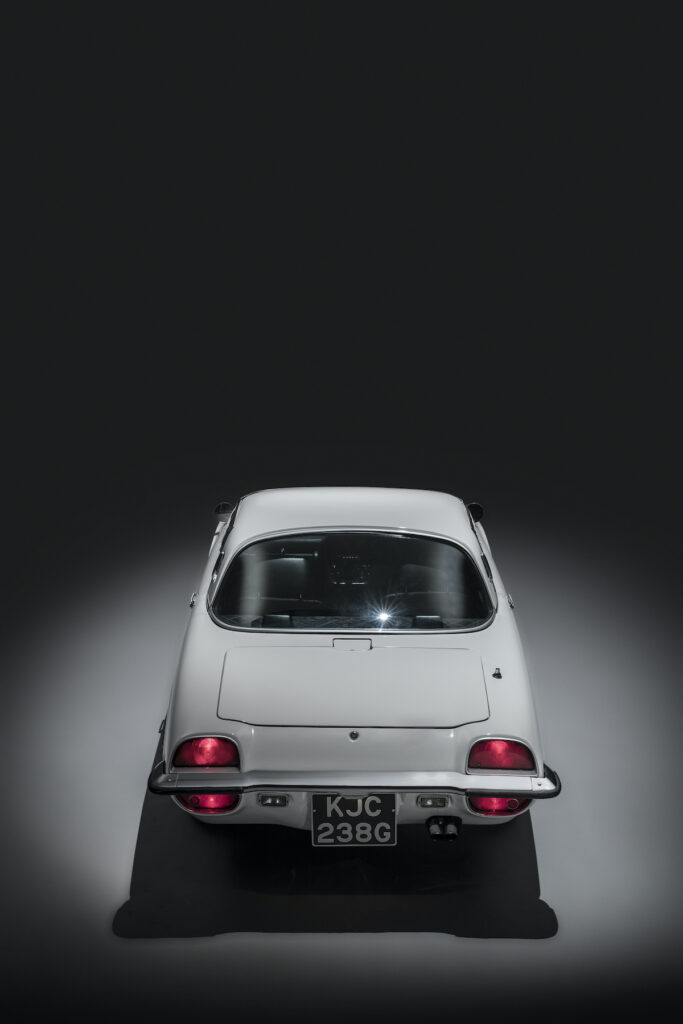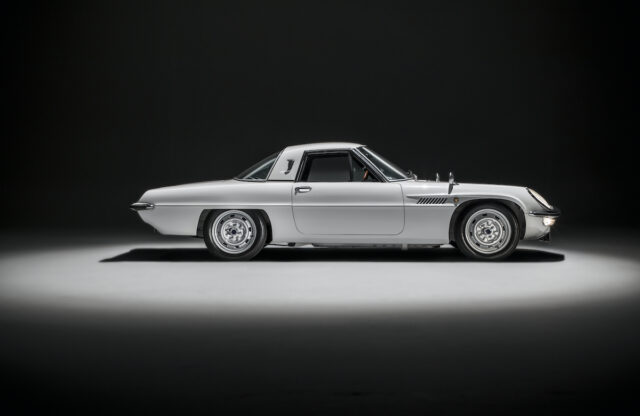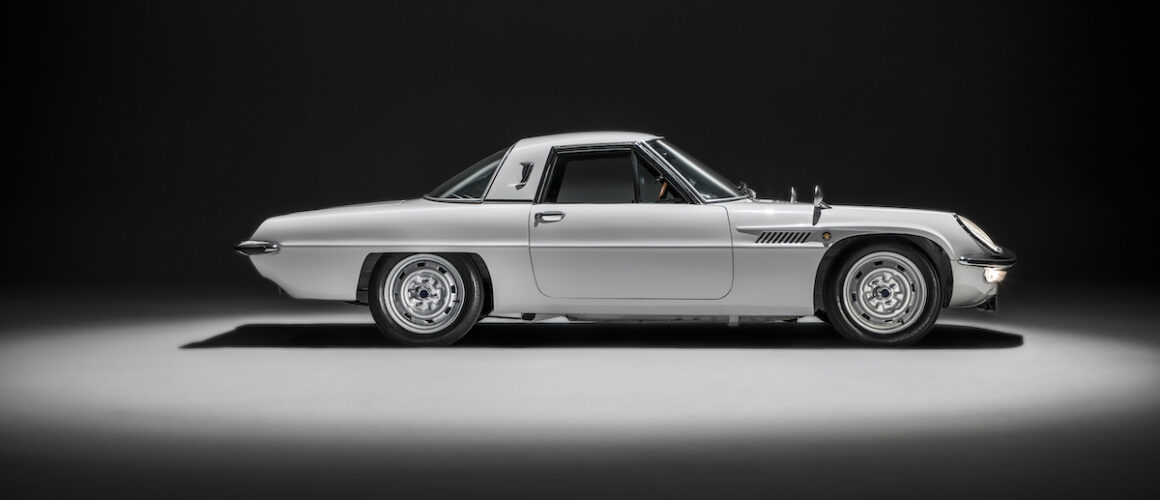Mazda’s first rotary-powered production car was sheer engineering mastery but failed to change the world. By the time of the model’s 50th anniversary back in 2018, the crazy world of the Cosmo had come full circle
There’s an anniversary here. It’s more than 50 years since you could first buy a proper production car with a Wankel rotary engine. Actually you could choose from two: the NSU Ro80, made by the company that first developed Felix Wankel’s invention for viable automotive use, and the Mazda Cosmo you see here, made by the company that got a licence from NSU to develop its own rotary engine and ended up making more of them than anyone else. Mazda built rotaries right up to 2012, and may do so again. Many car companies have dipped toes into rotary waters. Aerospace and motorcycle companies wet their feet too, all smitten with the prospect of so much power from such a compact package. Citroën, for example, experimented with the Ami-based, single-rotor M35 from 1969 and dived right in with the GS Birotor of 1974, but sales were disastrous (not helped by the energy crisis and the engine’s thirst) and it was canned. Then there was Mercedes-Benz. It made a couple of experimental mid-engined GTs designated C111, starting in 1969 with a three-rotor engine, then moving to a four-rotor before diverting its efforts to diesel engines for the next C111s. Norton made a rotary- engined motorcycle, good enough for police forces to trust. There were many more Wankel projects, mostly doomed. Through it all, though, NSU the pioneer and Mazda the evangelist loom largest.
Felix Wankel came up with his engine idea, involving a convex-sided triangular rotor rotating eccentrically within a trochoidal (pinched-oval) casing, as far back as 1929. But it wasn’t until 1951, when working for NSU, that he could develop it. His original version had a rotor housing that also rotated within a larger outer casing, but another NSU engineer, Hanns Dieter Paschke, devised a simpler version with a fixed casing. The first working prototypes of both first ran in 1957, and – to Wankel’s irritation – Paschke’s simpler reinterpretation got the nod. So Wankel, rotary, Paschke… any of these tags can justifiably describe the engine we came to know. US aircraft-engine manufacturer Curtiss-Wright joined forces with NSU in 1960 to develop Wankel engines further. A year later Toyo Kogyo, as the Mazda company was then called, sent some engineers to NSU’s factory in Neckarsulm to learn more about the revolutionary engine, with a view to making its own version under licence, and the engineers saw first-hand the problem that had been thwarting the rotary’s progress. That problem was the ‘chatter marks’ that had been ruining the chrome-plated rubbing surface of the aluminium rotor housing, where the iron seals on the rotor’s tips had been oscillating. Back in Hiroshima, Toyo Kogyo engine chief Kenichi Yamamoto and his team, reportedly fired up with a Samurai-like determination not to let this marvellous engine idea die, tried myriad alternative seal materials, including animal bone, but the chattering continued. The breakthrough came in 1963 with the design of an iron seal with a cross-shaped void inside it, which altered the resonant frequency of the seal and banished the chatter. There was still a problem with rapid wear, though, solved in 1965 by chief metallurgist Jun Miyata, who devised seals made from an aluminium-carbon mix. NSU was still using iron rotor tips in its 1963 Prinz Sport-based, single-rotor, limited-run NSU Wankel Spider built for evaluation by a few selected experts and customers, and the twin-rotor Ro80 was similarly equipped, with all the wear problems and company- destroying warranty costs this entailed. Mazda rotaries, by contrast, have mostly proved durable.
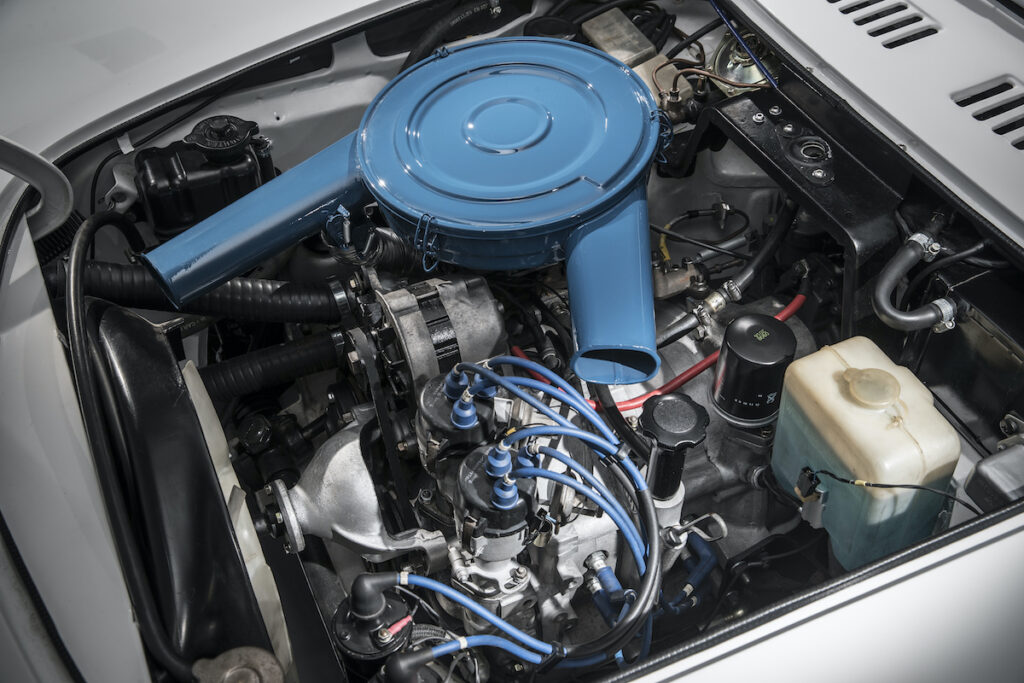
That NSU Spider was the first viable, semi- production, rotary-engined road car, but Mazda, too, had shown its hand in 1963 with the first Cosmo prototype. Its twin-rotor L8A engine had a total swept volume of 798cc, equivalent by the ‘doubling’ convention of the time to a 1596cc piston engine. A larger-engined Cosmo, its 110bhp 10A unit having a 982cc displacement, appeared at the 1964 Tokyo motor show, and from early 1965 the first of 80 pre- production Cosmos began to appear for testing by Mazda engineers and dealers. Finally, in mid-1967, the Cosmo 110S went on sale. IT’S LOW. VERY LOW. And on this 1968 Series II Cosmo, no longer a 110S because its 10B engine is uprated to 128bhp from the same 982cc capacity, is found nearly every sports-car motif deemed cool in themid-1960s. You could buy a Cosmo in Britain – the 110S cost £2606 on its early-1968 arrival here – but very few did. Mazda UK owns this particular Cosmo, recently acquired in pieces from Japan and restored here, and knows of only a couple of others in the UK: an orange example and one that was at the Goodwood Revival’s Bonhams auction. The Series II has a leering mouth below its front bumper where the Series I had eight vertical cooling slots, and a longer wheelbase (by about 6in) to calm the ride and handling. The overall length is unchanged; the extra length is inserted between the door’s rear edge and the rear wheelarch, with a corresponding reduction in rear overhang. Clearly Mazda’s designers liked the long-tail look, though, so the Series II’s rear bumper has less wraparound in order to maintain the space between arch and bumper-tip. Motor magazine’s February 1968 Cosmo road test refers to the body’s Bertone styling, but the writer might have been misled by the Italian design house’s work on the pretty Luce saloon, once quite popular in the UK. The look of the Cosmo, named to reflect the enthusiasm for the unfolding Space Age, was the work of Mazda’s own Heiji Kobayashi. His thought processes might have moved in parallel with Bertone’s, or even Michelotti’s, when devising strakes over wheelarches, but the Cosmo has a style all its own. So, the visual sportifiers. Headlights under clear covers, check. Streamlined wing mirrors, check (on the car originally, at least; this one has more modern replacements). Anti-lift vanes on the arms of the clap- hands wipers, check. Louvres in the front wings, check.
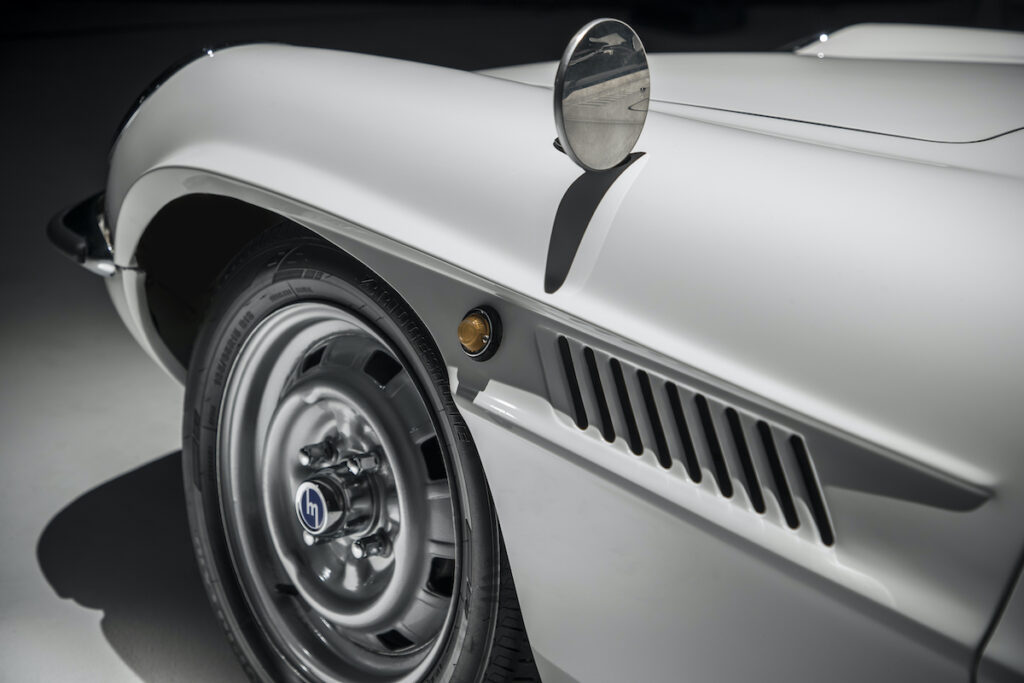
Footrest for the left foot, check – but missing from this car. And if we move round to the tail, we see big rear lights dissected by the bumper, brake lights illuminating all four lenses, the tail-lights illuminating just the upper pair, which also flash (still red) for the indicators. Inside, simple round dials fill a black instrument panel that is cowled and extended down towards the gearlever in quite a modern way. The switches look like aftermarket replacements, but they are authentic apart from the addition of actuators for horn and high beam to remedy non-functionality in the horn button and column stalk. The reach-adjustable Nardi-Danesesteering wheel is non-original – it’s like the one in some special-edition Mk1 MX-5s – but the vibe is right: original equipment was also a wood-rim three-spoker, but with holes instead of slots in the aluminium spokes. Snugly ensconced in the compact seats with their houndstooth vinyl centre sections, the Cosmo’s occupants have surprising legroom but feel very low to the ground. It feels just right, though, because the scuttle is similarly low thanks to the engine’s lack of height. The high transmission tunnel and gearlever remind you of the reality of the gearbox’s position relative to the axles, the fixed points. The rest of the Cosmo has simply sunk down among them.
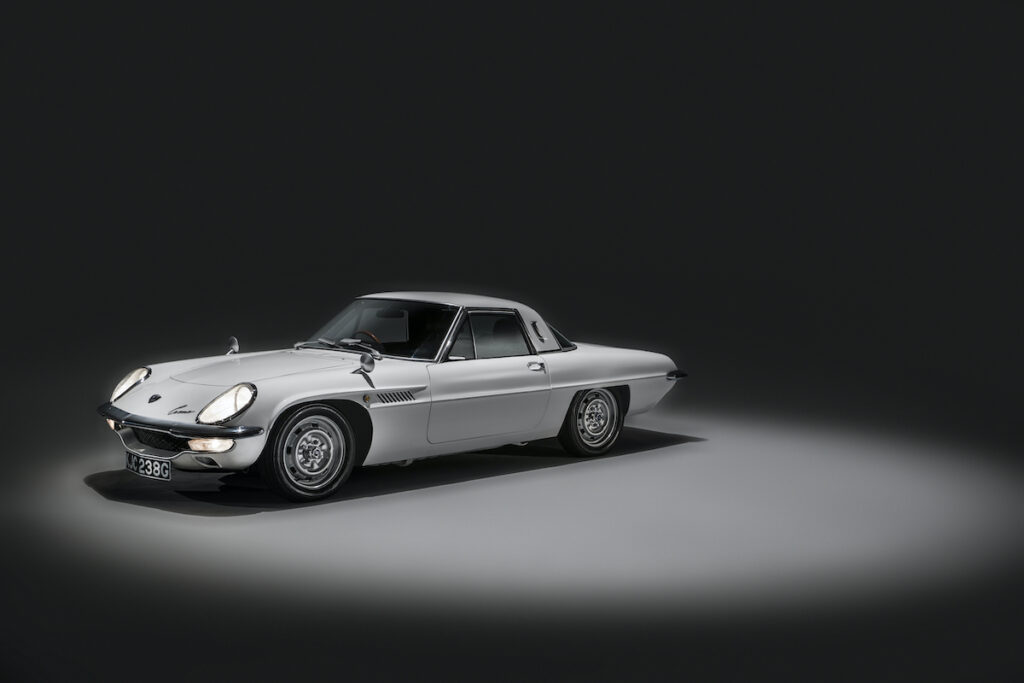
Time to start it up? Actually no, not yet. Let’s heave ourselves out again, pop open the front-hinged bonnet and have a good look at what’s about to propel us. It’s an engine that looks to consist entirely of a fat crankcase dotted with ancillaries, including two distributors, fed by a pair of coils, each firing current to one sparkplug per rotor. Why? Because one plug fires at two degrees after the rotary equivalent of top dead centre, the other at seven degrees. That’s because of the combustion chamber’s rather large surface area, and the need to get the flame front going in the right direction to encourage the rotor’s rotation. On which subject, the rotor doesn’t rotate at the speed recorded on the rev-counter, but one-third of that speed. The gearing inside the rotor ensures that the engine’s output shaft, the one whose speed the revcounter shows, has one firing pulse from each rotor for each of its revolutions. That’s two pulses per revolution in total, 180o apart – as in a four-cylinder, four-stroke piston engine. This explains why the exhaust note has a similar pitch to a piston engine’s, albeit a different sonic quality as we’ll discover. Under the air filter hides a four-choke carburettor designed by Stromberg and made by Hitachi. The two smaller chokes feed inlet ports opening to the side of each rotor, one at the front of the engine, one at the back. As the accelerator travels further, the large chokes join in and feed a second pair of inlet ports. The exhaust ports open on the periphery of the exhaust chamber,uncovered by the rotor tips.Which is where Mazda’s and NSU’s Wankel philosophy diverged. In NSU’s version of the rotary, both inlet and exhaust ports were ‘peripheral’, which gives higher peak power but worse low-speed torque and fuel consumption. NSU disguised this with a torque converter, but the Mazda’s transmission is a regular four-speed manual (with rather noisy indirect ratios) so the engine has to play by regular rules.
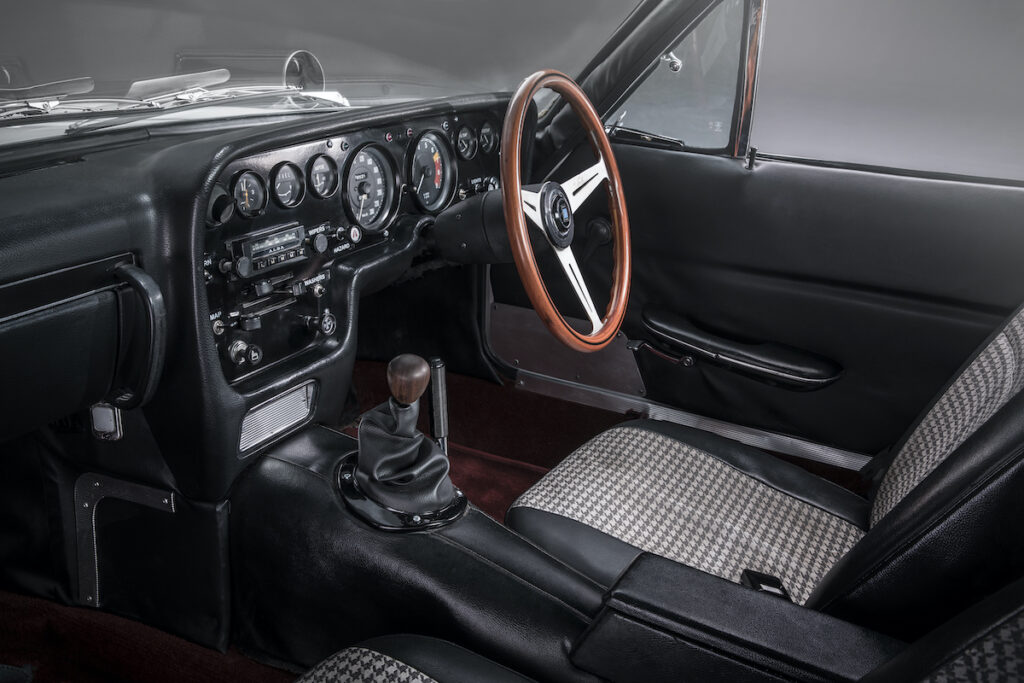
A quick glance under the Cosmo reveals rack-and- pinion steering, coil-and-wishbone front suspension, and a de Dion rear axle with sliding-spline driveshafts and leaf springs. That sounds a decent mix of ingredients for a 1960s sports car. So, do they gel? THIS IS AN ENGINE completely devoid of mechanical chatter and vibration, almost two-stroke- like as it rises through the rev range. There’s rather a lot of oil smoke, too. ‘It’s freshly built and it will get less smoky,’ say the Mazda people with optimism. Hope so; even my Saab 96 two-stroke is Euro 6 next to this.
A small amount of oil is squirted directly into the carburettor to lubricate those tip seals and ensure optimum gas sealing, and the Mazda minders have set it to the correct 2.2ml per seven minutes at idle. More than that is combusting here, though. ‘Such an amount of injection is not sufficient to cause smoke,’ reported the Motor test, in which three pints of oil were consumed in 1600 miles of ‘very enthusiastic motoring’ – not an excessive rate of consumption for the time. Smoke or not, this engine feels super-crisp with little inertia in its moving parts. It hums, it buzzes enthusiastically as the revs rise, and were it not for the revcounter needle’s upward arc ceasing at a flickering 4500rpm as the revs continue to build, I’m sure I would soon see visual confirmation of the 7000rpm at which that 128bhp is meant to arrive. However, in view of the engine’s newness I don’t want to rev it quite that hard.
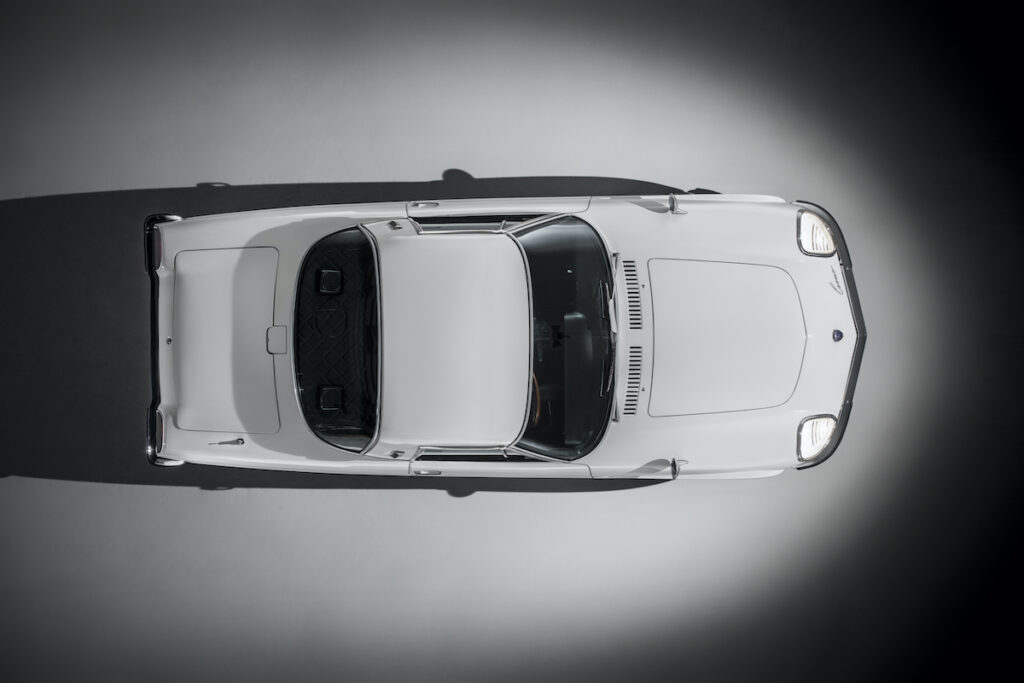
The power seems to fade before an estimated 7000rpm, too, a characteristic perhaps linked to the faltering revcounter, but the way the urge is delivered to that point ties in with thepromise of the torque’s 103lb ft peak at 5000rpm. Not that it’s dyspeptic at low revs. Far from it. In fact, it pulls cleanly from just 1500rpm, and vigorously enough not to enforce a downshift and a blast of revs. It’s no less docile or low-revs squirtable than, say, a torquey MGB. Only some two-stroke-like surging when feathering the throttle, or on the overrun, reminds you of the engine’s unusual architecture when you’re ambling. Post-Cosmo, it is said that a worryingly large proportion of Mazda RX-7 and RX-8 owners in the US didn’t even know their cars had a rotary engine.
So, is the Cosmo actually quick? The Series I managed 116mph and a 9.3-second 0-60mph time – a performance ‘midway between that of a Triumph TR4A and a Lotus Elan Plus 2, without the economy of either’, observed Motor – while Mazda UK has uncovered Series II figures of 126mph and 9.8sec to 62mph. It handles quite sweetly, too, with light but feelsome steering and the great road-widening advantage of narrowness. The tail bounces around too much, compromising precision and directional stability as well as the occupants’ backbones (the short-wheelbase version would have been worse), but provided the road is smooth the Cosmo flicks neatly through bends with an injection of power as the exit approaches. Better rear dampers would transform it. Braking is powerful enough, helped by the smallest servo I’ve yet seen. So that’s the road test bit. What matters more is that the Cosmo is a very rare car and to drive one is an equally rare treat. Only 343 Series Is and 1176 Series IIs were built up to the model’s demise in September 1972, but they set the tone for plenty of rotary glory to come.
Factfile – 1968 Mazda Cosmo Series II
Engine 982cc (equivalent to 1964cc) twin-rotor Wankel, aluminium casing, Hitachi-Stromberg four-choke carburettor Power 128bhp @ 7000rpm Torque 103lb ft @ 5000rpm Transmission Five-speed manual gearbox, rear-wheel drive Steering Rack and pinion Suspension Front: double wishbones, coil springs, telescopic dampers, anti-roll bar. Rear: de Dion axle, leaf springs telescopic dampers Brakes Discs front, drums rear Weight 960kg Top speed 126mph 0-62mph 9.8sec
This article was originally published in Octane 174, December 2017
